Multifaceted Geometric Assessment towards Simplified Urban Surfaces Built by 3D Reconstruction
Abstract
:1. Introduction
2. Related Work
2.1. Current Surface Assessment Methods
- Almost all the research in the literature on surface simplification has focused on describing the effects after limited exhibition of simplified results. However, this approach is too subjective. As illustrated in Figure 1, even without consideration of the uneven precision of 3D reconstruction, the interpretation of results using traditional methods often faces this challenge.
- Another type of assessment is the measurement of comprehensive error, including Hausdorff error, mean error, and RMS error, using a tool called Metro [20], which is lacking in the demonstration of the error of important details, as shown in Figure 2. The series of indexes applied in our work aims to solve this weakness.
- The third method relies on indexes that are related to the simplification algorithms, which can be prone to circular arguments. They also lack robustness, so it is extremely difficult to compare them with other algorithms according to these quantified indexes.
2.2. Current Surface Classification Methods
2.3. Tested Simplification Algorithms
3. Classification of Urban Surfaces
3.1. Extraction of Planar Vertices
3.2. Extraction of Planar Surfaces
- Dihedral angles of edges: This method is frequently applied when the edges directly link two adjacent faces. When the dihedral angle of edges (maximum: ) is larger than the threshold of the dihedral angle set, the two faces that share the corresponding edge are recognized as planar ones. The calculation of the dot products of normal vectors determines the dihedral angles of edges.
- Recognition of planar vertices: Planar vertices are recognized by using the threshold of fluctuation parameter obtained above.
- Recognition of planar vertices with extension: Building on the basis of the recognition of planar vertices, the average dihedral angle of the edges of the recognized planar surfaces is calculated, and the average angle is regarded as the threshold of dihedral angles. All sub-planar edges are traversed until all the dihedral angles of sub-planar edges are larger than the threshold.
3.3. Extraction of Urban Frameworks
4. Sampling
4.1. Detailed Surfaces
4.2. Urban Frameworks
5. Assessment Implementation
5.1. Assessment Indexes
- Mean error of planar surfaces: The sampled surface serves as the pivot (sampled) surface [20], and the mean error is obtained by measuring the sampling points of different types of surfaces, which are classified in Section 3. For measuring the mean error of detailed and planar surfaces, input surfaces serve as the only pivot surfaces because the aim is to pick a larger error, and this mean error is larger than that in Metro [20]. Metro adopts dual measurement to obtain the Hausdorff distance, which was not used in our studies. For measuring the mean error of urban frameworks, simplified surfaces are used as the pivot surfaces, as explained in Section 4.
- Planarity indicator : Most planar surfaces in urban models can be seen as entirely planar after simplification because of the limited precision of 3D reconstruction [28]. This concept is expressed numerically here. Specifically, the larger the value of , the more satisfactory the planar surfaces.
- Proportion of faces among detailed surfaces : This index is the proportion of the faces among detailed surfaces compared with all the surfaces. A larger value of implies that more geometric elements are located on detailed surfaces, which is likely conducive to the preservation of surface and indicating areas for improvement. A larger also implies fewer geometric elements for planar surfaces, which corresponds to a larger in most cases because planarity is accurately achieved with fewer faces, as illustrated in Figure A1c (Appendix A).
- Error disparity of detailed surfaces : The error disparity is fundamental for exploring areas for improving simplification algorithms, and it is independent of comprehensive errors. Larger numerical errors of detailed surfaces are not equivalent to failures. When the error of detailed surfaces is larger than its own comprehensive error, the simplification algorithm is worth further exploring. If the errors of detailed and planar surfaces are and , respectively, and the comprehensive error measured by Metro is , then
- The gap between errors from different simplification algorithms : This is for more precise analyses when the disparity of different error measurements is too small to conduct accurate analyses. In (8), symbolizes the mean error of the type of surfaces classified at the same simplification rate.
5.2. Implementation
| Algorithm 1. Implementation of multifaceted geometric assessment for simplified urban surfaces built by 3D reconstruction. The process determines the method to use for planar surface extraction and whether to implement extraction and mean error measurement of urban frameworks. | |
| Assessment Based on Surface Classification | |
| 1 | Insert (1x.obj, 2x.obj); bool fluct, frmk /*1x.obj is the input surface */ |
| 2 | 1x.obj, 2x.obj /*Obtain Fluctuation parameter */ |
| 3 | Weight_vt 1x.obj, 2x.obj /*Obtain weight of each vertex */ |
| 4 | [<=] 1x.obj, 2x.obj /*Obtain number of consecutive surface clusters and is the independent variable */ |
| 5 | = findthresholdFluct (, Weight_vt, [<=]) |
| 6 | () 2x.obj /*Test for choice of classification method */ |
| 7 | Obtain proportion of virtual faces compared with all the detailed surfaces |
| 8 | cin >> fluct; cin >> frmk /* Judge the best way to extract planar surfaces and whether to extract urban frameworks, as illustrated in Figure 8 and Figure 9 */ |
| 9 | iffluct == true then /* Recognition of planar vertices with extension is adopted */ |
| 10 | Planar_vt ≤ |
| 11 | Sub_planar_expand () /*Extraction using method 3 */ |
| 12 | end |
| 13 | iffluct == false then /* Dihedral angles of edges are adopted */ |
| 14 | Planar_extract () /* Extraction using method 1 */ |
| 15 | end /* Sub-planar edges and virtual faces are also obtained */ |
| 16 | Obtain planarity of planar surfaces |
| 17 | Obtain face share of detailed surfaces |
| 18 | Sample detailed surfaces (1x.obj) |
| 19 | Measure mean error of detailed surfaces |
| 20 | Obtain error disparity of detailed surfaces |
| 21 | iffrmk == true then /*Implement extraction and mean error measurement of urban frameworks */ |
| 22 | Sample sub-planar edges and calculate weight of sampling points (1x.obj) |
| 23 | Measure mean error of urban frameworks |
| 24 | end |
| 25 | return |
6. Experiments and Discussions
6.1. Error Measurement
6.2. Improvement through Combination
- Choose the lowest simplification rate at DVDC, which is the same number of vertices as the input surfaces for so-called simplification. This procedure is also named remeshing [42].
- Implement edge collapse through aQSlim.
6.3. Choice of Optimal Parameter
6.4. Time Property
7. Conclusions
- Classification was achieved by extracting planar surfaces. For input surfaces, this study adopted weighted vertices and the number of consecutive surfaces, as well as their relations to fluctuation parameters, to determine the threshold of fluctuation parameters. Simplified surfaces based on the estimated number of consecutive surfaces of input surfaces is the proper method selected to extract planar surfaces. Given these comprehensive considerations, urban surfaces were classified accurately.
- The results of sampling the pivot surfaces reveal that the mean errors of detailed surfaces and urban frameworks were more capable of measuring the preservation capacity of simplified surfaces than the commonly used tool Metro.
- This article proposes indexes that are based on classification and go beyond measuring mean errors. Other indexes not only facilitate the in-depth understanding of simplification algorithms but also support the improvement of the quality of simplified surfaces through the easy combination of off-the-shelf simplification algorithms.
- The mean error of urban frameworks extracted from simplified surfaces not only meets the needs of framework preservation but is also stable in its determination of the optimal variable parameter of simplification algorithms for some urban surfaces.
Author Contributions
Funding
Acknowledgments
Conflicts of Interest
Appendix A



References
- Nash, C.; Williams, C.K.I. The shape variational autoencoder: A deep generative model of part-segmented 3D objects. Comput. Graph. Forum 2017, 36, 1–12. [Google Scholar] [CrossRef] [Green Version]
- Jackson, B.; Jelke, B.; Brown, G. Yea Big, Yea High: A 3D User Interface for Surface Selection by Progressive Refinement in Virtual Environments. In Proceedings of the 25th IEEE Conference on Virtual Reality and 3D User Interfaces (VR), Reutlingen, Germany, 18–22 March 2018; pp. 320–326. [Google Scholar]
- Jung, J.W.; Lee, J.S.; Cho, D.W. Computer-aided multiple-head 3D printing system for printing of heterogeneous organ/tissue constructs. Sci. Rep. 2016, 6, 21685. [Google Scholar] [CrossRef] [PubMed]
- Gong, J.; Cui, K.; Zhang, W.; Ding, Y.; Huang, B.; Lu, Y.; Wang, J. Design and realization of active infrared imaging system based on power-over-fiber technique. Opt. Rev. 2018, 25, 517–522. [Google Scholar] [CrossRef]
- El-Asha, S.; Zhan, L.; Iungo, G.V. Quantification of power losses due to wind turbine wake interactions through SCADA, meteorological and wind LiDAR data. Wind Energy 2017, 20, 1823–1839. [Google Scholar] [CrossRef]
- Arashpour, M.; Heidarpour, A.; Akbar Nezhad, A.; Hosseinifard, Z.; Chileshe, N.; Hosseini, R. Performance-based control of variability and tolerance in off-site manufacture and assembly: Optimization of penalty on poor production quality. Constr. Manag. Econ. 2019, 1–13. [Google Scholar] [CrossRef]
- Biljecki, F.; Stoter, J.; Ledoux, H.; Zlatanova, S.; Çöltekin, A. Applications of 3D City Models: State of the Art Review. ISPRS Int. J. Geogr. Inf. 2015, 4, 2842–2889. [Google Scholar] [CrossRef] [Green Version]
- Wang, A.; An, N.; Zhao, Y.; Iwahori, Y.; Kang, R. 3D Reconstruction of Remote Sensing Image Using Region Growing Combining with CMVS-PMVS. Int. J. Multimed. Ubiquitous Eng. 2016, 11, 29–36. [Google Scholar] [CrossRef]
- Zhao, Y.; Liu, Y. Patch based saliency detection method for 3D surface simplification. In Proceedings of the 21th International Conference on Pattern Recognition, Tsukuba, Japan, 11–15 November 2012; pp. 845–848. [Google Scholar]
- Holzmann, T.; Maurer, M.; Fraundorfer, F.; Bischof, H. Semantically Aware Urban 3D Reconstruction with Plane-Based Regularization. In Proceedings of the 15th European Conference on Computer Vision (ECCV), Munich, Germany, 8–14 September 2018; pp. 468–483. [Google Scholar]
- Ran, M.; Xiao, S.; Zhou, X.; Xiao, W. Asphalt Pavement Texture 3D Reconstruction Based on Binocular Vision System with SIFT Algorithm. In Proceedings of the International Conference on Smart Grid & Electrical Automation, Changsha, China, 27–28 May 2017; pp. 213–218. [Google Scholar]
- Bacharidis, K.; Sarri, F.; Paravolidakis, V.; Ragia, L.; Zervakis, M. Fusing Georeferenced and Stereoscopic Image Data for 3D Building Façade Reconstruction. ISPRS Int. J. Geogr. Inf. 2018, 7, 151. [Google Scholar] [CrossRef]
- Islam, M.B.; Wong, L.K.; Low, K.L.; Wong, C.O. Warping-based Stereoscopic 3D Video Retargeting with Depth Remapping. In Proceedings of the 2019 IEEE Winter Conference on Applications of Computer Vision (WACV), Hilton Waikoloa Village, HI, USA, 7–11 January 2019; pp. 1655–1663. [Google Scholar]
- Biasotti, S.; Thompson, E.M.; Barthe, L.; Berretti, S.; Giachetti, A.; Lejemble, T.; Tortorici, C. Recognition of geometric patterns over 3D models. In Proceedings of the 11th Eurographics Workshop on 3D Object Retrieval, Eurographics Association, Delft, The Netherlands, 16 April 2018; pp. 71–77. [Google Scholar]
- Wang, X.; Burghardt, D. A Mesh-Based Typification Method for Building Groups with Grid Patterns. ISPRS Int. J. Geogr. Inf. 2019, 8, 168. [Google Scholar] [CrossRef]
- Goesele, M.; Snavely, N.; Curless, B.; Hoppe, H.; Seitz, S.M. Multi-view stereo for community photo collections. In Proceedings of the IEEE 11th International Conference on Computer Vision, Rio de Janeiro, Brazil, 14–21 October 2007; pp. 1–8. [Google Scholar]
- Fuhrmann, S.; Langguth, F.; Goesele, M. MVE: A multi-view reconstruction environment. In Proceedings of the 12th Eurographics Workshop on Graphics and Cultural Heritage, Eurographics Association, Darmstadt, Germany, 6–8 October 2014; pp. 11–18. [Google Scholar]
- Furukawa, Y.; Curless, B.; Seitz, S.M.; Szeliski, R. Towards Internet-scale multi-view stereo. In Proceedings of the 23th Computer Vision and Pattern Recognition, San Francisco, CA, USA, 13–18 June 2010; pp. 1434–1441. [Google Scholar]
- Altantsetseg, E.; Khorloo, O.; Matsuyama, K.; Konno, K. Complex hole-filling algorithm for 3D models. In Proceedings of the 34th Computer Graphics International Conference, Yokohama, Japan, 27–30 June 2017; pp. 1–6. [Google Scholar]
- Cignoni, P.; Rocchini, C.; Scopigno, R. Metro: Measuring Error on Simplified Surfaces; Computer Graphics Forum: Oxford, UK; Blackwell Publishers: Hoboken, NJ, USA, 1998; Volume 17, pp. 167–174. [Google Scholar]
- Yao, L.; Huang, S.; Xu, H.; Li, P. Quadratic Error Metric Mesh Simplification Algorithm Based on Discrete Curvature. Math. Probl. Eng. 2015, 2015, 1–7. [Google Scholar] [CrossRef]
- Zhou, Y.F.; Zhang, C.; He, P. Feature preserving mesh simplification algorithm based on square volume measure. Chin. J. Comput. 2009, 32, 203–212. [Google Scholar] [CrossRef]
- Liu, S.; Ferguson, Z.; Jacobson, A.; Gingold, Y.I. Seamless: Seam erasure and seam-aware decoupling of shape from mesh resolution. ACM Trans. Graph. 2017, 36, 1–216. [Google Scholar] [CrossRef]
- Garland, M.; Heckbert, P.S. Surface simplification using quadric error metrics. In Proceedings of the 24th Annual Conference on Computer Graphics and Interactive Techniques, Los Angeles, CA, USA, 3–8 August 1997; ACM Press/Addison-Wesley Publishing Co.: New York, NY, USA, 1997; pp. 209–216. [Google Scholar] [Green Version]
- Liu, Y.J.; Xu, C.X.; Fan, D.; He, Y. Efficient construction and simplification of Delaunay meshes. ACM Trans. Graph. 2015, 34, 174. [Google Scholar] [CrossRef]
- Uccheddu, F.; Servi, M.; Furferi, R.; Governi, L. Comparison of Mesh Simplification Tools in a 3D Watermarking Framework. In International Conference on Intelligent Interactive Multimedia Systems and Services; De Pietro, G., Gallo, L., Howlett, R., Jain, L.C., Eds.; Springer: Gold Coast, Australia, 2018; pp. 60–69. [Google Scholar]
- Valette, S.; Chassery, J.M. Approximated Centroidal Voronoi Diagrams for Uniform Polygonal Mesh Coarsening; Computer Graphics Forum: Oxford, UK; USA Blackwell Publishing Inc.: Hoboken, NJ, USA, 2004; Volume 23, pp. 381–389. [Google Scholar]
- Salinas, D.; Lafarge, F.; Alliez, P. Structure-Aware Mesh Decimation; Computer Graphics Forum: Oxford, UK; USA Blackwell Publishing Inc.: Hoboken, NJ, USA, 2015; Volume 34, pp. 211–227. [Google Scholar]
- Nealen, A.; Igarashi, T.; Sorkine, O.; Alexa, M. Laplacian mesh optimization. In Proceedings of the International Conference on Computer Graphics & Interactive Techniques in Australasia & Southeast Asia, Kuala Lumpur, Malaysia, 29 November–2 December 2006; pp. 381–389. [Google Scholar]
- Wang, K.; Torkhani, F.; Montanvert, A. A fast roughness-based approach to the assessment of 3D mesh visual quality. Comput. Graph. 2012, 36, 808–818. [Google Scholar] [CrossRef]
- Zeineldin, R.A.; El-Fishawy, N.A. Fast and accurate ground plane detection for the visually impaired from 3D organized point clouds. In Proceedings of the 2016 IEEE SAI Computing Conference, London, UK, 13–15 July 2016; pp. 373–379. [Google Scholar]
- Maltezos, E.; Ioannidis, C. Automatic Extraction of Building Roof Planes from Airborne LIDAR Data Applying AN Extended 3d Randomized Hough Transform. ISPRS Ann. Photogramm. Remote Sens. Spat. Inf. Sci. 2016, 3, 209–216. [Google Scholar] [CrossRef]
- Sampath, A.; Shan, J. Segmentation and Reconstruction of Polyhedral Building Roofs from Aerial Lidar Point Clouds. IEEE Trans. Geosci. Remote Sens. 2010, 48, 1554–1567. [Google Scholar] [CrossRef]
- Valette, S.; Chassery, J.M.; Prost, R. Generic remeshing of 3D triangular meshes with metric-dependent discrete Voronoi diagrams. IEEE Trans. Vis. Comput. Graph. 2008, 14, 369–381. [Google Scholar] [CrossRef] [PubMed]
- Löwner, M.O.; Gröger, G.; Benner, J.; Biljecki, F.; Nagel, C. Proposal for a new LOD and multi-representation concept for CityGML. ISPRS Ann. Photogramm. Remote Sens. Spat. Inf. Sci. 2016, 4, 3–12. [Google Scholar] [CrossRef]
- Schmidt, R.; Singh, K. Meshmixer: An Interface for Rapid Mesh Composition. ACM SIGGRAPH 2010 Talks; ACM: Los Angeles, CA, USA, 2010; p. 6. [Google Scholar]
- Shuchat, A. Generalized Least Squares and Eigenvalues. Am. Math. Mon. 1985, 92, 656–659. [Google Scholar] [CrossRef]
- Cignoni, P.; Callieri, M.; Corsini, M.; Dellepiane, M.; Ganovelli, F.; Ranzuglia, G. Meshlab: An open-source mesh processing tool. In Proceedings of the Eurographics Italian Chapter Conference, Salerno, Italy, 2–4 July 2008; pp. 129–136. [Google Scholar]
- Frey, P.J.; Borouchaki, H. Surface mesh quality assessment. Int. J. Numer. Methods Eng. 1999, 45, 101–118. [Google Scholar] [CrossRef]
- POV-Ray-The Persistence of Vision Raytracer. Available online: http://www.povray.org/ (accessed on 17 August 2018).
- Isoda, Y.; Tsukamoto, A.; Kosaka, Y.; Okumura, T.; Sawai, M.; Yano, K.; Tanaka, S. Reconstruction of Kyoto of the Edo era based on arts and historical documents: 3D urban model based on historical GIS data. Int. J. Humanit. Arts Comput. 2009, 3, 21–38. [Google Scholar] [CrossRef]
- Pellerin, J.; Lévy, B.; Caumon, G.; Botella, A. Automatic surface remeshing of 3D structural models at specified resolution: A method based on Voronoi diagrams. Comput. Geosci. 2014, 62, 103–116. [Google Scholar] [CrossRef]
- Nießner, M.; Zollhöfer, M.; Izadi, S.; Stamminger, M. Real-time 3D reconstruction at scale using voxel hashing. ACM Trans. Graph. 2013, 32, 169. [Google Scholar] [CrossRef]

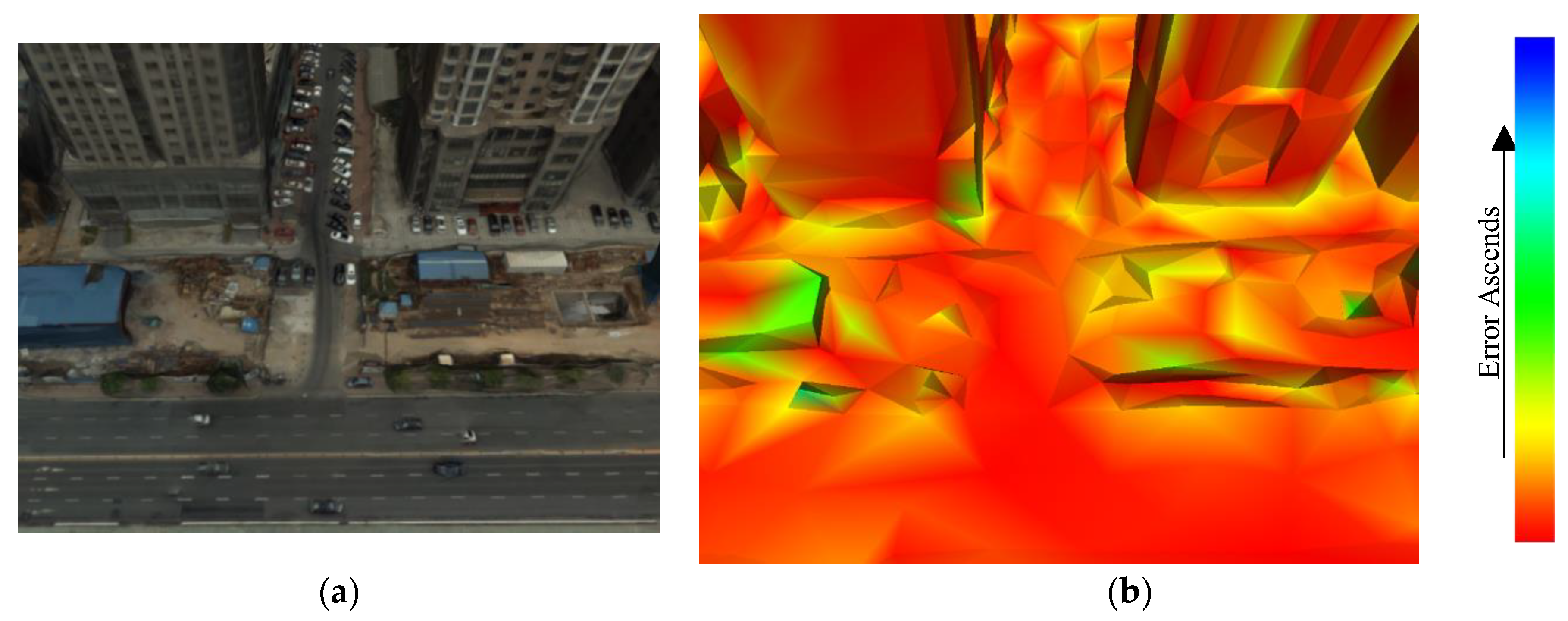
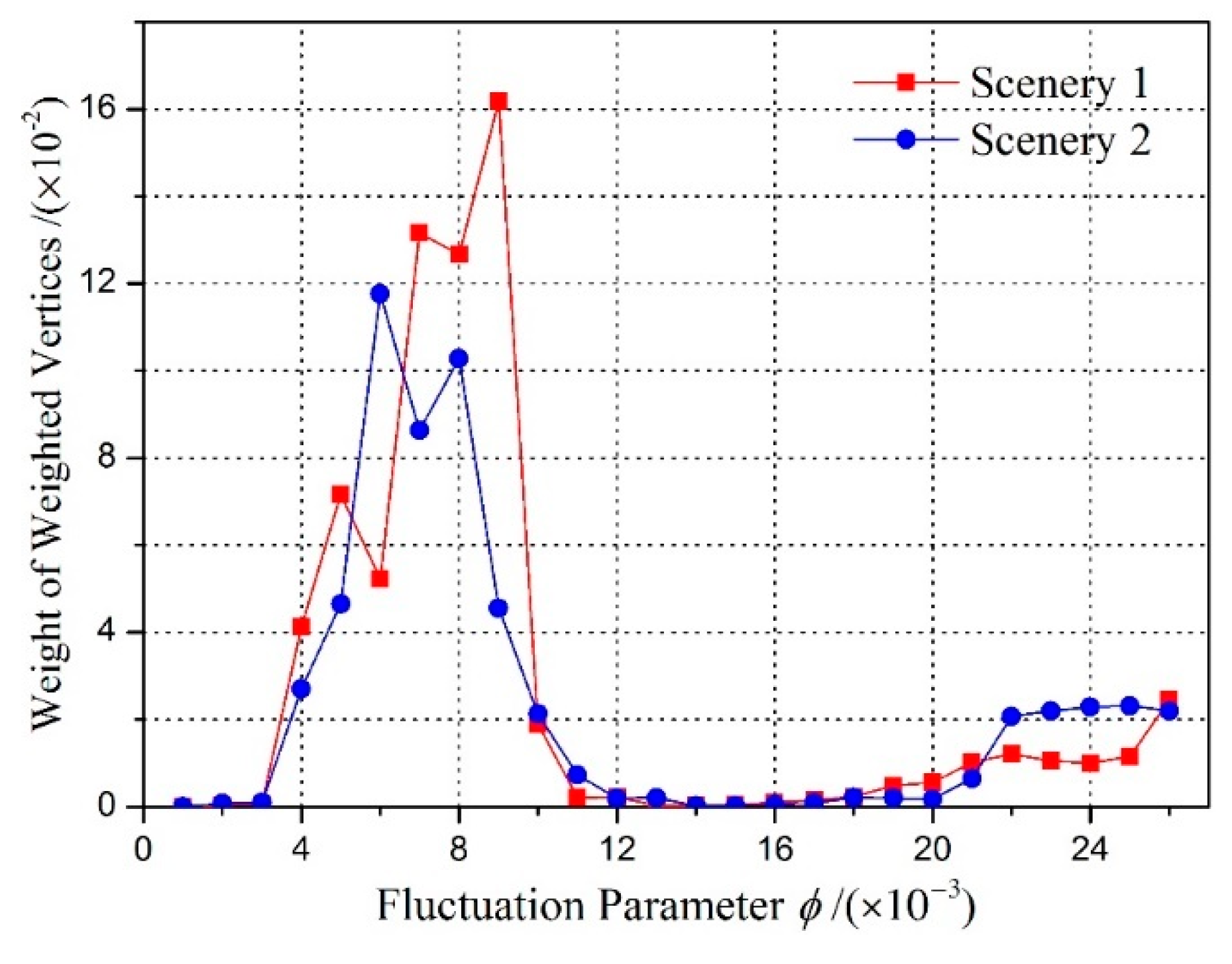


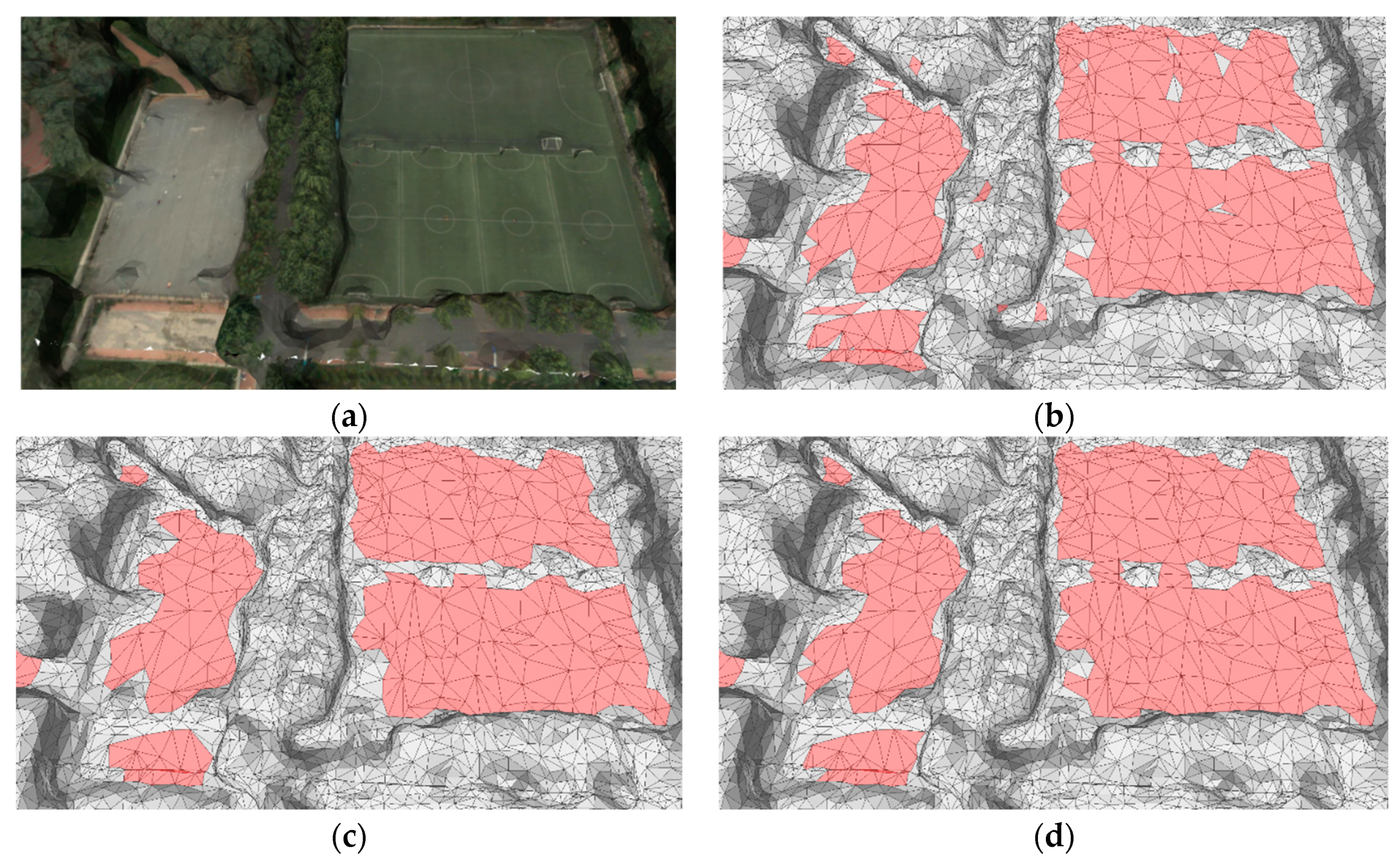

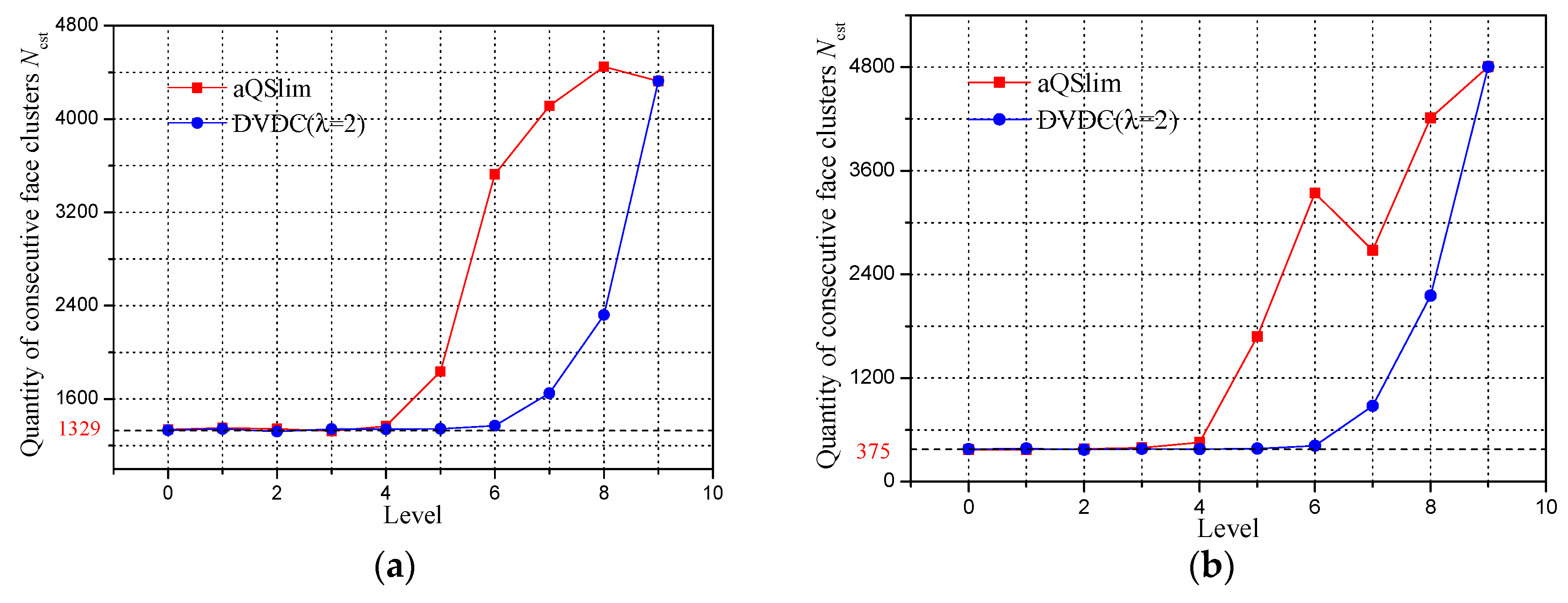

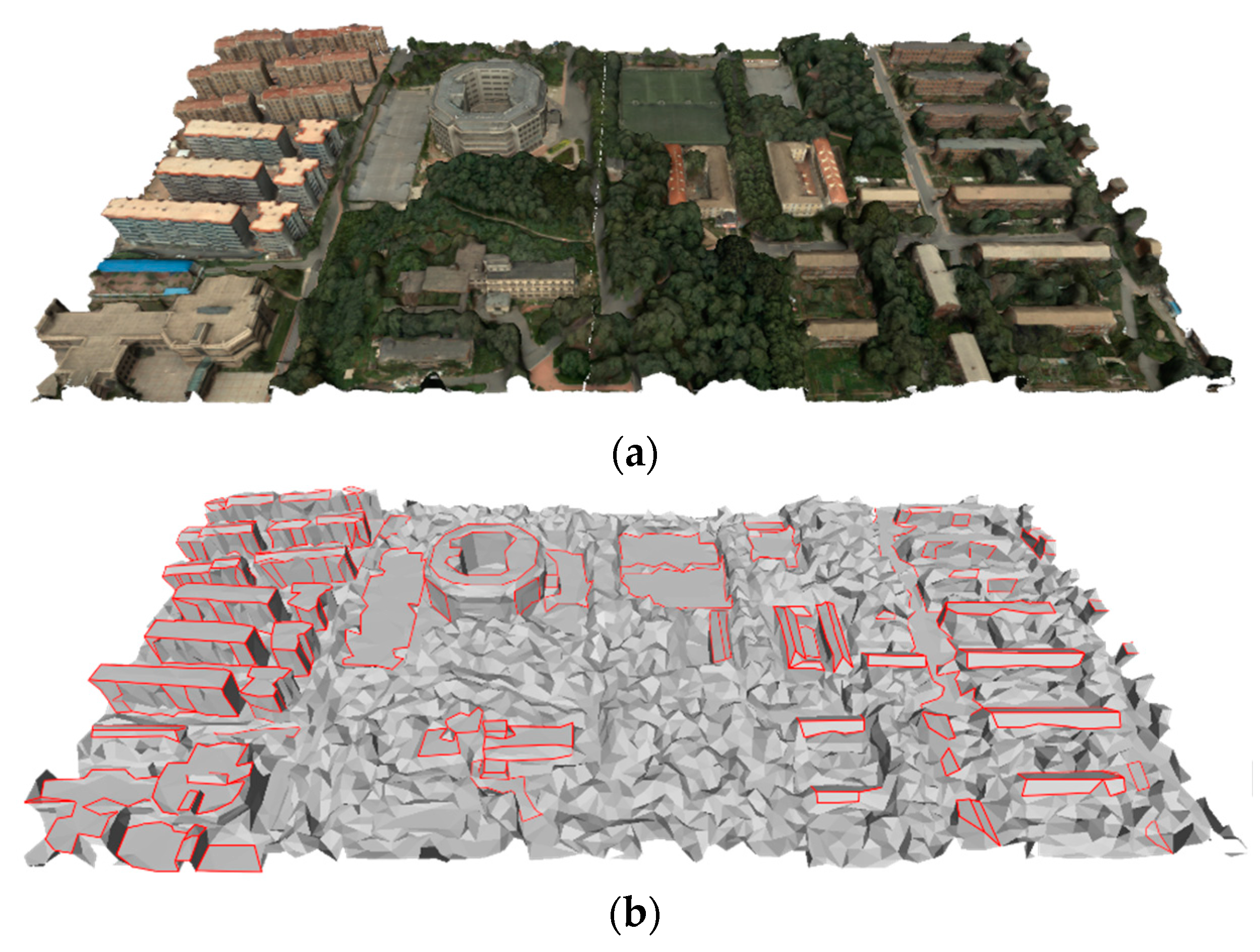


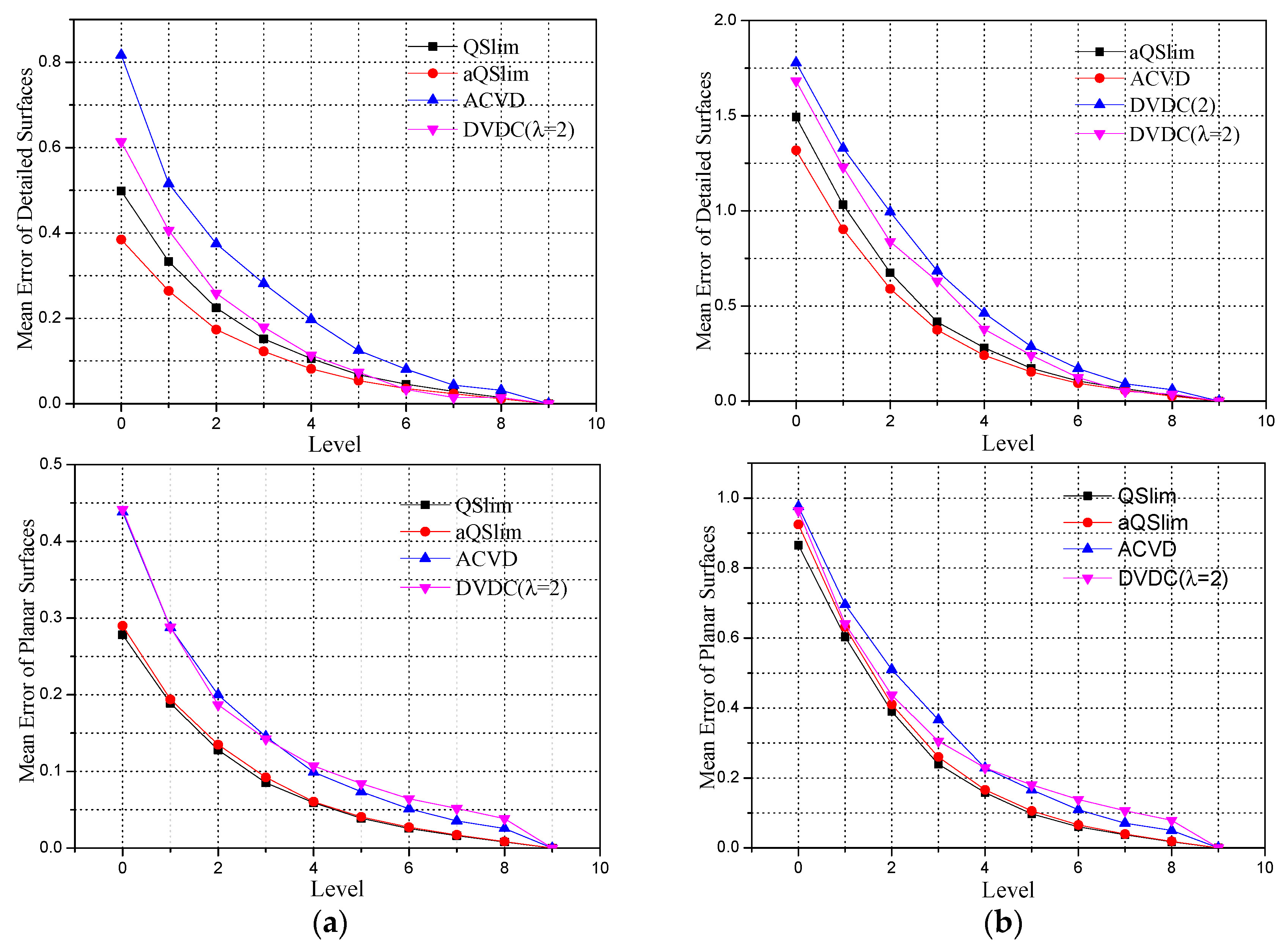

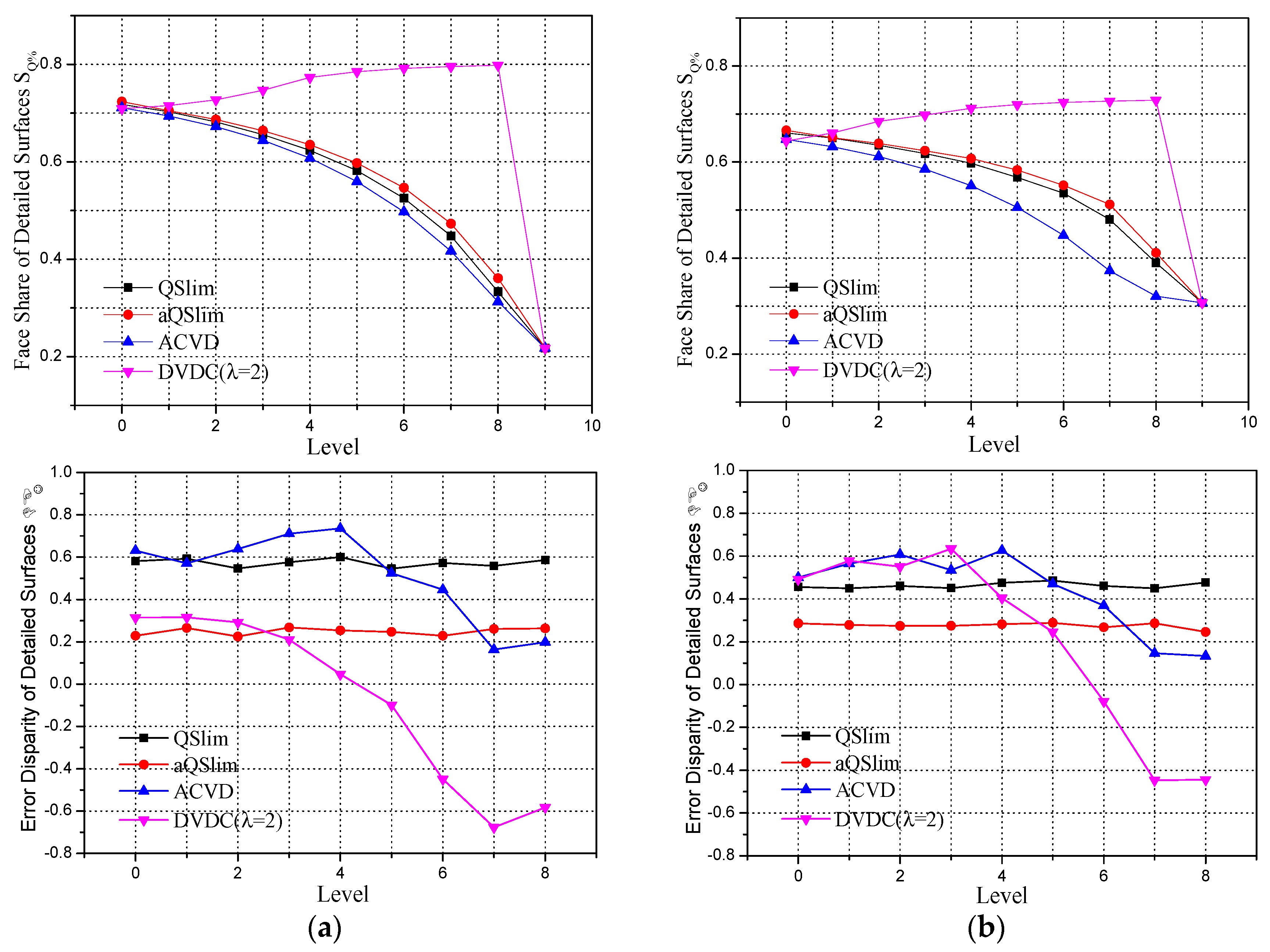
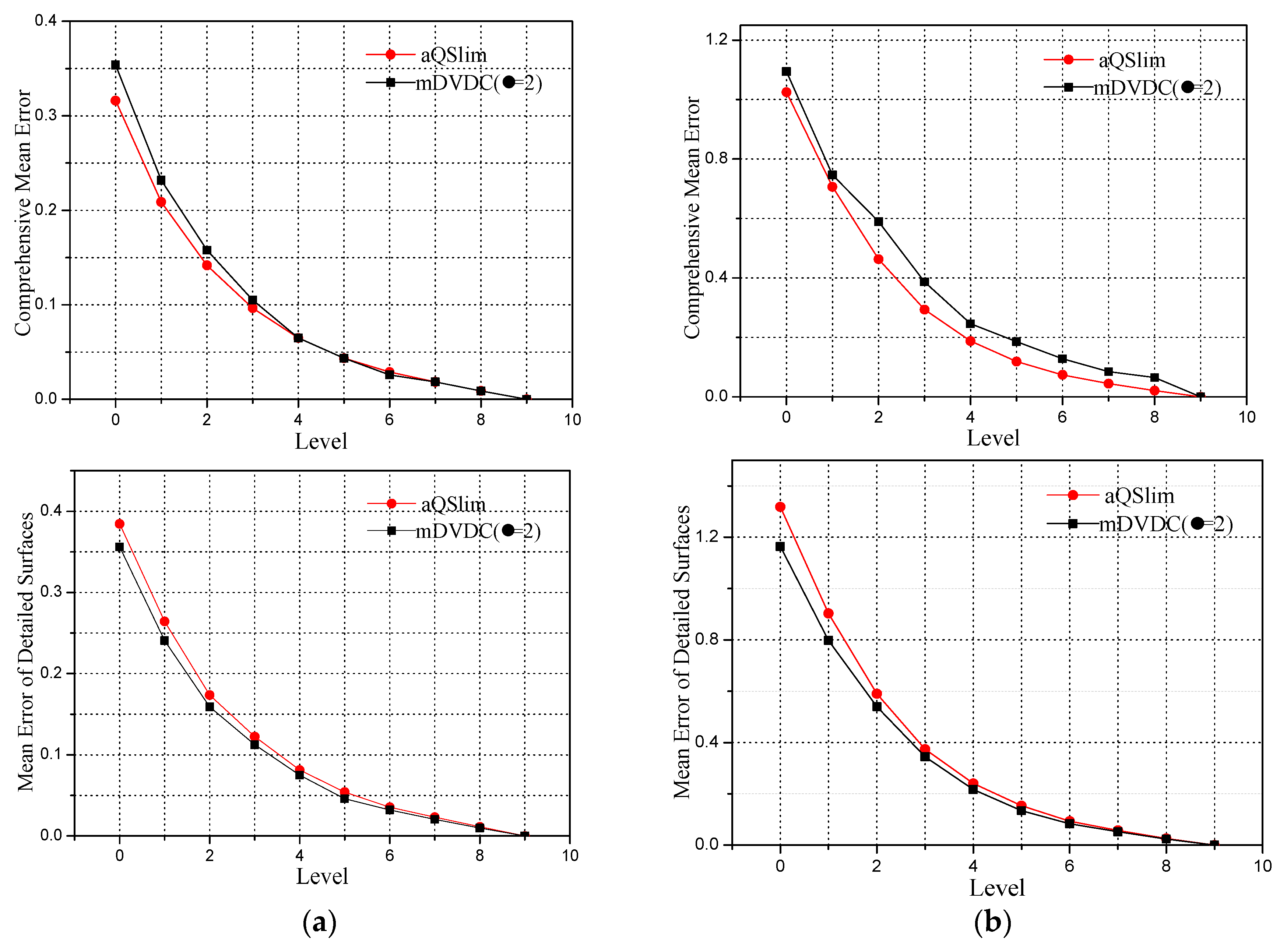
| Mean Error of | Level | ||||
|---|---|---|---|---|---|
| Detailed Surfaces | 4 | 2.2 | 2.3 | 0.027 | 0.088 |
| 3 | 2.3 | 2.4 | 0.015 | 0.093 | |
| 2 | 2.4 | 2.3 | 0.011 | 0.094 | |
| 1 | 2.3 | 2.4 | 0.012 | 0.101 | |
| 0 | 2.3 | 2.4 | 0.017 | 0.082 | |
| Urban Frameworks | 4 | 2.3 | 2.2 | 0.018 | 0.073 |
| 3 | 2.2 | 2.3 | 0.011 | 0.101 | |
| 2 | 2.3 | 2.2 | 0.013 | 0.081 | |
| 1 | 2.3 | 2.4 | 0.012 | 0.078 | |
| 0 | 2.3 | 2.4 | 0.014 | 0.075 |
| Mean Error of | Level | ||||
|---|---|---|---|---|---|
| Detailed Surfaces | 4 | 1.9 | 1.7 | 0.014 | 0.164 |
| 3 | 2.0 | 1.8 | 0.013 | 0.137 | |
| 2 | 1.7 | 1.8 | 0.016 | 0.147 | |
| 1 | 1.8 | 2.0 | 0.020 | 0.187 | |
| 0 | 1.7 | 1.8 | 0.012 | 0.186 | |
| Urban Frameworks | 4 | 1.8 | 1.7 | 0.017 | 0.142 |
| 3 | 1.8 | 1.9 | 0.015 | 0.161 | |
| 2 | 1.7 | 1.8 | 0.013 | 0.139 | |
| 1 | 1.9 | 1.8 | 0.018 | 0.118 | |
| 0 | 1.8 | 1.9 | 0.016 | 0.158 |
| Surface | Face No | Metro (/s) | Without Framework Measurement (/s) | With Framework Measurement (/s) |
|---|---|---|---|---|
| Scenery 1 | 3145277 | 167.26 | 149.17 | 173.14 |
| Scenery 2 | 2392672 | 141.51 | 127.99 | 145.63 |
| Tile A | 109936 | 7.2891 | 10.318 | 12.346 |
| Tile B | 160834 | 9.8672 | 13.911 | 14.713 |
© 2019 by the authors. Licensee MDPI, Basel, Switzerland. This article is an open access article distributed under the terms and conditions of the Creative Commons Attribution (CC BY) license (http://creativecommons.org/licenses/by/4.0/).
Share and Cite
Liu, S.; Yi, H.; Chen, X.; Wang, D.; Jin, W. Multifaceted Geometric Assessment towards Simplified Urban Surfaces Built by 3D Reconstruction. ISPRS Int. J. Geo-Inf. 2019, 8, 360. https://doi.org/10.3390/ijgi8080360
Liu S, Yi H, Chen X, Wang D, Jin W. Multifaceted Geometric Assessment towards Simplified Urban Surfaces Built by 3D Reconstruction. ISPRS International Journal of Geo-Information. 2019; 8(8):360. https://doi.org/10.3390/ijgi8080360
Chicago/Turabian StyleLiu, Sheng’en, Hui Yi, Xiangning Chen, Decheng Wang, and Wei Jin. 2019. "Multifaceted Geometric Assessment towards Simplified Urban Surfaces Built by 3D Reconstruction" ISPRS International Journal of Geo-Information 8, no. 8: 360. https://doi.org/10.3390/ijgi8080360





